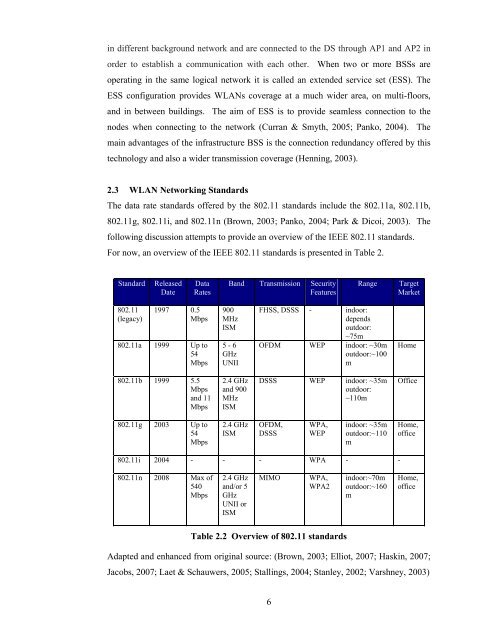AIS300 - Scheme of Work - Scholarly Commons Home
AIS300 - Scheme of Work - Scholarly Commons Home
AIS300 - Scheme of Work - Scholarly Commons Home
Create successful ePaper yourself
Turn your PDF publications into a flip-book with our unique Google optimized e-Paper software.
in different background network and are connected to the DS through AP1 and AP2 in<br />
order to establish a communication with each other. When two or more BSSs are<br />
operating in the same logical network it is called an extended service set (ESS). The<br />
ESS configuration provides WLANs coverage at a much wider area, on multi-floors,<br />
and in between buildings. The aim <strong>of</strong> ESS is to provide seamless connection to the<br />
nodes when connecting to the network (Curran & Smyth, 2005; Panko, 2004). The<br />
main advantages <strong>of</strong> the infrastructure BSS is the connection redundancy <strong>of</strong>fered by this<br />
technology and also a wider transmission coverage (Henning, 2003).<br />
2.3 WLAN Networking Standards<br />
The data rate standards <strong>of</strong>fered by the 802.11 standards include the 802.11a, 802.11b,<br />
802.11g, 802.11i, and 802.11n (Brown, 2003; Panko, 2004; Park & Dicoi, 2003). The<br />
following discussion attempts to provide an overview <strong>of</strong> the IEEE 802.11 standards.<br />
For now, an overview <strong>of</strong> the IEEE 802.11 standards is presented in Table 2.<br />
Standard<br />
802.11<br />
(legacy)<br />
Released<br />
Date<br />
Data<br />
Rates<br />
1997 0.5<br />
Mbps<br />
802.11a 1999 Up to<br />
54<br />
Mbps<br />
802.11b 1999 5.5<br />
Mbps<br />
and 11<br />
Mbps<br />
802.11g 2003 Up to<br />
54<br />
Mbps<br />
Band Transmission Security<br />
Features<br />
900<br />
MHz<br />
ISM<br />
5 - 6<br />
GHz<br />
UNII<br />
2.4 GHz<br />
and 900<br />
MHz<br />
ISM<br />
2.4 GHz<br />
ISM<br />
FHSS, DSSS - indoor:<br />
depends<br />
outdoor:<br />
6<br />
~75m<br />
OFDM WEP indoor: ~30m<br />
outdoor:~100<br />
m<br />
DSSS WEP indoor: ~35m<br />
outdoor:<br />
~110m<br />
OFDM,<br />
DSSS<br />
WPA,<br />
WEP<br />
802.11i 2004 - - - WPA<br />
802.11n 2008 Max <strong>of</strong><br />
540<br />
Mbps<br />
2.4 GHz<br />
and/or 5<br />
GHz<br />
UNII or<br />
ISM<br />
MIMO WPA,<br />
WPA2<br />
Table 2.2 Overview <strong>of</strong> 802.11 standards<br />
Range Target<br />
Market<br />
indoor: ~35m<br />
outdoor:~110<br />
m<br />
- -<br />
indoor:~70m<br />
outdoor:~160<br />
m<br />
<strong>Home</strong><br />
Office<br />
<strong>Home</strong>,<br />
<strong>of</strong>fice<br />
<strong>Home</strong>,<br />
<strong>of</strong>fice<br />
Adapted and enhanced from original source: (Brown, 2003; Elliot, 2007; Haskin, 2007;<br />
Jacobs, 2007; Laet & Schauwers, 2005; Stallings, 2004; Stanley, 2002; Varshney, 2003)

















